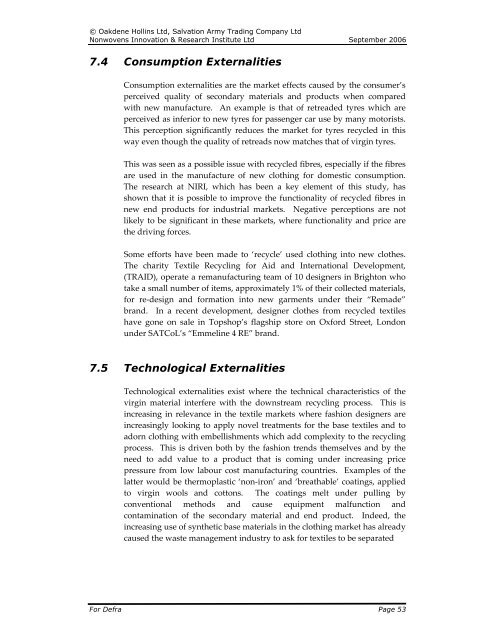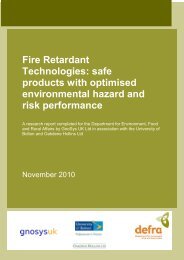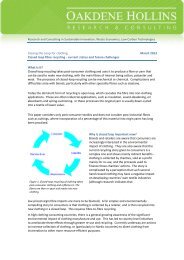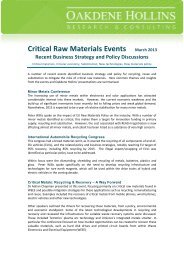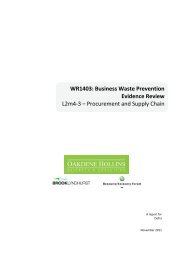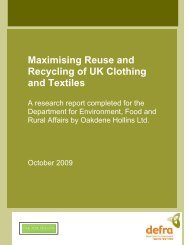Recycling of Low Grade Clothing Waste - Oakdene Hollins
Recycling of Low Grade Clothing Waste - Oakdene Hollins
Recycling of Low Grade Clothing Waste - Oakdene Hollins
You also want an ePaper? Increase the reach of your titles
YUMPU automatically turns print PDFs into web optimized ePapers that Google loves.
© <strong>Oakdene</strong> <strong>Hollins</strong> Ltd, Salvation Army Trading Company Ltd<br />
Nonwovens Innovation & Research Institute Ltd September 2006<br />
7.4 Consumption Externalities<br />
Consumption externalities are the market effects caused by the consumer’s<br />
perceived quality <strong>of</strong> secondary materials and products when compared<br />
with new manufacture. An example is that <strong>of</strong> retreaded tyres which are<br />
perceived as inferior to new tyres for passenger car use by many motorists.<br />
This perception significantly reduces the market for tyres recycled in this<br />
way even though the quality <strong>of</strong> retreads now matches that <strong>of</strong> virgin tyres.<br />
This was seen as a possible issue with recycled fibres, especially if the fibres<br />
are used in the manufacture <strong>of</strong> new clothing for domestic consumption.<br />
The research at NIRI, which has been a key element <strong>of</strong> this study, has<br />
shown that it is possible to improve the functionality <strong>of</strong> recycled fibres in<br />
new end products for industrial markets. Negative perceptions are not<br />
likely to be significant in these markets, where functionality and price are<br />
the driving forces.<br />
Some efforts have been made to ‘recycle’ used clothing into new clothes.<br />
The charity Textile <strong>Recycling</strong> for Aid and International Development,<br />
(TRAID), operate a remanufacturing team <strong>of</strong> 10 designers in Brighton who<br />
take a small number <strong>of</strong> items, approximately 1% <strong>of</strong> their collected materials,<br />
for re‐design and formation into new garments under their “Remade”<br />
brand. In a recent development, designer clothes from recycled textiles<br />
have gone on sale in Topshop’s flagship store on Oxford Street, London<br />
under SATCoL’s “Emmeline 4 RE” brand.<br />
7.5 Technological Externalities<br />
Technological externalities exist where the technical characteristics <strong>of</strong> the<br />
virgin material interfere with the downstream recycling process. This is<br />
increasing in relevance in the textile markets where fashion designers are<br />
increasingly looking to apply novel treatments for the base textiles and to<br />
adorn clothing with embellishments which add complexity to the recycling<br />
process. This is driven both by the fashion trends themselves and by the<br />
need to add value to a product that is coming under increasing price<br />
pressure from low labour cost manufacturing countries. Examples <strong>of</strong> the<br />
latter would be thermoplastic ‘non‐iron’ and ‘breathable’ coatings, applied<br />
to virgin wools and cottons. The coatings melt under pulling by<br />
conventional methods and cause equipment malfunction and<br />
contamination <strong>of</strong> the secondary material and end product. Indeed, the<br />
increasing use <strong>of</strong> synthetic base materials in the clothing market has already<br />
caused the waste management industry to ask for textiles to be separated<br />
For Defra Page 53


